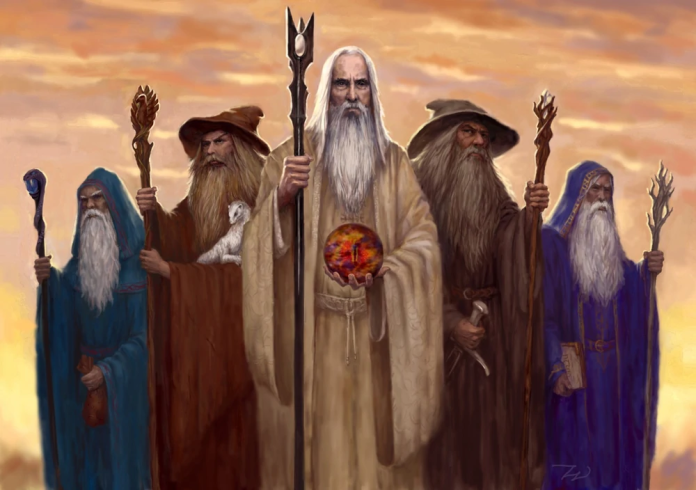Gandalf the Grey appeared in print for the first time on September 21, 1937. The Hobbit received high praise from critics (internal link to blog 4), and grew slowly in popularity through the next few decades. The stereotypical wizard, Gandalf appeared in Tolkien’s major trilogy, the Lord of the Rings, forming one of the key members of the Fellowship.
But as we noted earlier, Gandalf was not the only Wizard in town, er, in Middle-Earth. There were five wizards, who were in fact ancient spirits known as Maiar, sent from the West into Middle-Earth. Of the five, two wizards vanished from the known lands of Middle-Earth quite quickly, journeying into the East and out of Tolkien’s tales. There’s a bit more to it than that, as we looked at, but with the two Blue Wizards gone, three wizards were left to play roles in the Lord of the Rings. Having covered Gandalf in depth, I’m going to look now at the remaining two. First up, the eccentric but oddly-important Radagast.
Radagast the Brown
If there’s a ranking of the wizards, Radagast is a solid third place. He gets surprisingly few mentions in Tolkien’s work. There’s really one “important” scene of his in the entire Lord of the Rings trilogy, and that’s about it. But despite the paucity of information about him, Radagast has captured the admiration of numerous Tolkien fanatics.
Radagast was the wizard of nature, of field and stream. Particularly fond of birds, he was largely a loner. He shunned most human contact; his home was at Rhosgobel, near the southern border of Mirkwood (The Hobbit, Chapter Seven, “Queer Lodgings”). Mirkwood itself was home to some pretty aloof people – remember the entire kingdom of Wood-Elves who lived there, isolated from nearly everyone except the men of Laketown? And of course, Mirkwood was home to many strange and magical creatures, from mysterious squirrels to giant spiders. All that to say, Radagast was clearly more at home with flora and fauna than with men or elves.
Nevertheless, he was a member of the White Council, the most powerful and wisest people in Middle-Earth, and a friend of Gandalf’s. Much of the speculation about Radagast centers around what kind of “quiet” role he might have played in the Wars of the Ring. His position near Mirkwood may have meant that he was assigned by the Council to keep an eye on Dol Guldur and the Necromancer, later revealed to be Sauron reborn. Radagast’s natural affinity for birds also makes him a key candidate to be responsible for the involvement of the Eagles in the events at the close of The Return of the King.
Gandalf credited Radagast as a “master of shapes and changes of hue,” which has given rise to some more “creative” theories that it was Radagast, not Saruman or Gandalf, who was seen at the eaves of Fangorn forest in The Two Towers. A tall, bent old man, wearing a wide-brimmed hat and leaning on a staff, appeared to Gimli, Aragorn, and Legolas. The scene in the books is a cryptic one; the man says nothing, does nothing, then vanishes. Soon afterwards, the horses ran away. Some fans see in the scene a depiction of Radagast, appearing, watching, then fading away.
There’s both more and less to Radagast’s character than there appears, I think. Tolkien seemed to make a point that the Istari’s (wizard’s) mission was to guide and guard the world from Sauron’s rise, unfallen angels against a fallen one. Particularly, that mission focused on protecting the world of men. Part of the success of failure of each of the wizards seems to relate to how involved they were with that world. Saruman gravitated first to Elves, then to men, then to isolation. He would eventually fall. The two Blue Wizards barely stayed in the story, or in the known world, at all, and soon vanished (presumably fallen or at least abandoning their mission, though that is somewhat debated). While Radagast stayed in the “world of men,” he existed only on the fringes of it, and avoided involvement with anyone other than the White Council and birds and beasts. Thus, in some ways he too failed, although he did not fall into evil. Only Gandalf remained entirely true to his mission. Only he actually fought in the battles against Sauron, and so only he really succeeded.
That might be stretching the point slightly – but it is interesting to note that though five wizards went into Middle Earth, only one returned to the West. Radagast, fascinating and helpful though he was, was doomed to remain behind.
Saruman the White
Saruman the White, one of the most tragic characters in all of Tolkien’s books. Like Gollum, another character who notably falls into darkness and evil, Saruman’s arc is ever-downward. But unlike Gollum, Saruman had much farther to fall.
Saruman was originally the leader of the Istari, the most powerful and wisest of the Maia sent from the West. He wore a white robe, revealed later to be the color of authority among the Wizards, and not simply a personal preference. Saruman led the White Council, and was instrumental in driving out the Necromancer from Dol Guldur.
However, Saruman had in his long history in Middle Earth become obsessed with knowledge and power rather than people. He grew friendly with the men of Rohan, who gave him the tower of Orthanc for his stronghold. In Orthanc, he found one of the legendary seeing-stones, the palantir, long thought lost or destroyed. As a side-note, the palantir were almost mind-bogglingly ancient, created in the Elder Days before the foundation of Middle Earth, by the High Elves themselves. In the early days of Middle Earth, the stones had been used by the kingdoms of Men to communicate, warn, and counsel each other. Many were lost over the years, and some of the stones fell into the hands of the Nazgul, the fallen Nine Lords of Men. Saruman used his palantir wisely at first, at least seemingly so, although he kept its existence a secret. All the time, he grew increasingly interested in the One Ring.
Saruman’s study of lore taught him the history of the Ring better than anyone. He knew it had been lost, not destroyed, and he searched the old battlegrounds of the Gladden Fields for it (with Radagast’s help). However, failing to find it, he amassed all the knowledge and power he could. Sometime after the events of The Hobbit, Saruman grew too curious. Searching for the Ring with his palantir, or simply gazing too closely at the lands of Mordor, he discovered the re-emerged Dark Lord.
At that point, something changed. Tolkien did not elaborate clearly on what caused Saruman’s fall, only that he spent too long gazing into the abyss, as it were. Saruman studied the dark magics of Sauron, initially in order to defeat him. Soon he began to desire that power for himself, particularly the Ring. He nurtured an inborn desire for power; that desire, coupled with the authority given to him, and Sauron’s subtle influence through the palantir, joined to send Saruman over the edge. In the events of the Lord of the Rings, Saruman first attempted an alliance with Sauron. Later, he betrayed Sauron, revealing that his ultimate goal had been to seize the Ring and become the Dark Lord himself.
Saruman was always clever. Tolkien emphasized this through Saruman’s attempt to use technological and magical mastery to win battles, rather than through brute force. Saruman’s crowning achievement was the creation of a new breed of Orcs, without the fatal flaw all other Orcs held of being weak and afraid in the sunlight. In the events recounted in “The Scouring of the Shire,” (Return of the King) Saruman revealed a taste for “modern” technology, and a ruthless willingness to use anything to achieve his ends.
Gandalf stripped Saruman of his title, broke his staff, took the Keys of Orthanc from him, and exiled him. Later, Saruman was killed in the Shire by Grima Wormtongue, his own servant.
Saruman represents a fall from grace. In the Lord of the Rings, Sauron, who is also a Maia like Saruman, is evil and has been that way for millennia. His “fall” was ancient; Saruman’s fall is recent – the reader watches it play out in the books. Tolkien also uses Saruman as a sort of stand-in for the evils and perils of technology. There’s an almost overtly environmental message to Saruman’s character. Saruman burns forests, wrecks trees, dams rivers, all to serve his purpose. In doing so, he loses his ties to the natural world – and by extension, some of his authority as a wizard. This fit in with some of Tolkien’s descriptions of industrialization elsewhere. In The Hobbit, for instance, he talks about the Orcs and their machinery.
Saruman came to a sad end, fallen from grace, fallen from power, bereft of nearly all of his authority. The once-greatest of the Five Wizards abrogated his position to Gandalf the Grey, now Gandalf the White.
And that is my quick-and-dirty summary of the Five Wizards!








